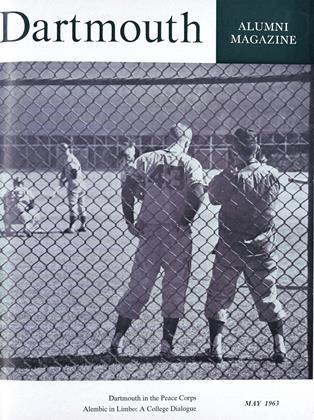I have just received the ALUMNI MAGAZINE containing the excellent review of Sanborn Brown's Count Rumford: Physicist Extraordinary which I had obtained from our South Norwalk Library a few months ago.
In the fall of 1919 I had just returned to Hanover to teach in Thayer School when Dr. Griggs asked whether anything could be done to correct the smoking fireplace in what was then the earliest Moose Mountain Cabin. The College Library (Wilson Hall then) had one reference to Fireplaces, which was to a volume of Rumford's collected essays late in the 1700's. His analysis of the action of a proper fireplace was amazing, and his specifications and suggestions were superb.
Ledyard Canoe Club then had a cabin on a tiny island opposite the outlet of the Ompompanoosuc River and the Club wanted a fireplace and was willing to try Rumford's. So a proper drawing was made to scale, and a reliable mason found who built it of brick. The layout and dimensions checked perfectly, and the fireplace worked. No smoking. John Dallas, then Rector of the Hanover Episcopal Church (later Bishop of New Hampshire) donated a carved board for the face, with Robert Louis Stevenson's words from a canoeing experience—"He Clung To His Paddle."
Thereupon the Outing Club, following Dr. Griggs' approval, authorized a new fireplace in Moose, and it, too, worked. Both of these fireplaces were without the metal frames that later enabled a stonemason to build one with only a few added specifications based on Rumford's recommendations, such as proportions of the opening, sloping of the side walls, sloping of the back wall, width of the back shelf, height of shelf above arch, size of flue (at least 10% of fireplace opening), smooth transition section from shelf to flue, and height of chimney (at least two feet higher than highest part of the roof).
Altogether, between 1919 and 1929 some dozen fireplaces were built in Outing Club and private cabins, following Ruraford's ideas - even one on Moosilauke, in the old Summit House, where the chief complaint seemed to be that it was too damned far down to fuel at the tree line.
Rumford was quite a fellow, with strengths and weaknesses even as you and I. He had both the thirst for knowledge and an astonishing ability to provide the means to get the information, and also the engineer's ability to translate the knowledge into practical devices. His accomplishments in many other fields such as diet, management, etc., are almost incredible considering his time.
I look forward eagerly to the publication of the full-length biography on which Professor Brown is working.
 View Full Issue
View Full Issue
More From This Issue
-
 Feature
FeatureDARTMOUTH IN THE PEACE CORPS
May 1963 By Clifford L. Jordan Jr. '45 -
 Feature
FeatureALEMBIC IN LIMBO: A College Dialogue
May 1963 By DAVID McCORD -
 Feature
FeatureLewis Dayton Stilwell (1891-1963)
May 1963 -
 Class Notes
Class Notes1931
May 1963 By WILLARD C. WOLFF, WILLIAM T. WENDELL -
 Class Notes
Class Notes1911
May 1963 By NATHANIEL G. BURLEIGH, JOSHUA B. CLARK -
 Article
ArticleTHE UNDERGRADUATE CHAIR
May 1963 By CARL MAVES '63
Article
-
 Article
ArticleTHE PROGRAM—HOUR BY HOUR
November 1928 -
 Article
ArticleThe Hanover Scene
May 1954 By BILL McCARTER 19 -
 Article
ArticleThe Birdman
Nov/Dec 2007 By Bonnie Barber -
 Article
ArticleThayer School
JANUARY 1959 By ED BROWN '35 -
 Article
ArticleDARTMOUTH MEDICAL SCHOOL, ITS PRESENT STATUS AND ITS POSSIBILITIES
August, 1914 By Frederic Pomeroy Lord '98 -
 Article
ArticleReport from the Council
June 1987 By Mark Harty '73

